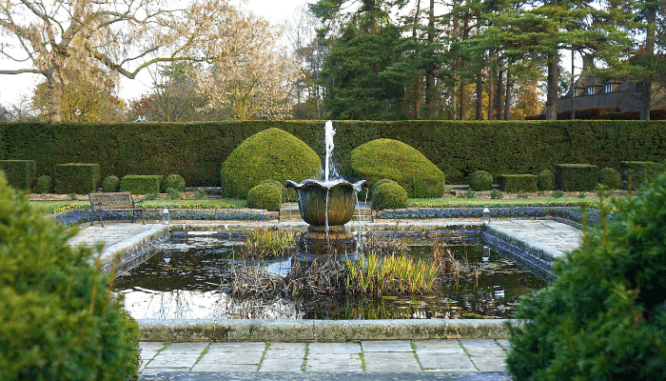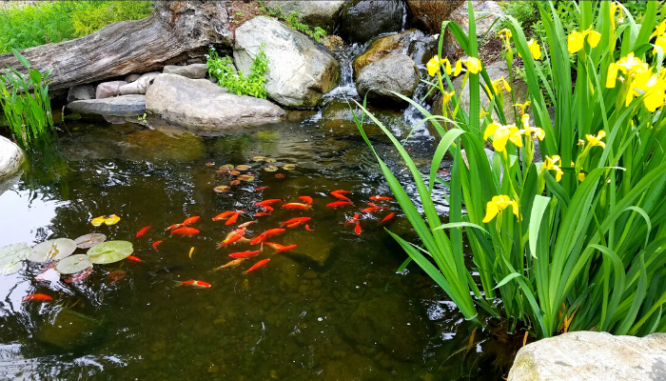Do Water Features Add Home Value or Do They Have Limited Appeal?
- Published on
- 5 min read
-
 Christine Bartsch Contributing AuthorClose
Christine Bartsch Contributing AuthorClose Christine Bartsch Contributing Author
Christine Bartsch Contributing AuthorFormer art and design instructor Christine Bartsch holds an MFA in creative writing from Spalding University. Launching her writing career in 2007, Christine has crafted interior design content for companies including USA Today and Houzz.
The calming cascades of a waterfall. The relaxing ripples on a koi pond. The gentle trickle of a fountain. The happy chirps and splashes from a birdbath. Water features are a beautiful, tranquil option to perk up your home’s backyard vibe or your front yard curb appeal.
However, you might be surprised to find out how they impact your home’s value.
“Most water features won’t add value in terms of dollars; however, they do add an aesthetic value. Water features add curb appeal, make the house more inviting, and buyers tend to feel more relaxed and stay longer as they’re viewing the house,” says Bethany Mendoza, a Move Safe certified agent in the Modesto, California area.
In short, the primary reason homeowners install a water feature is for their own personal enjoyment, not to increase their home’s value. And in some cases, installing a water feature might actually make your home harder to sell, or even devalue it.
On the other hand, a water feature might be just the showstopper you need to enhance your home’s vibe. Read on to learn everything you need to know before adding a water feature to your landscaping.

Why do homeowners add water features?
It might surprise you to learn that there are some pretty deep reasons why flowing, falling water appeals to people.
A recent study from the American Association for the Advancement of Science found that simply looking at a water feature improves a person’s mental health and wellbeing.
Psychology Today reviewed almost 40 recent studies about water features, also called “blue spaces,” and found that they also reduce stress and lower the risk for depression.
With a reputation like that, you’d think every home would have a water feature — but they don’t. Therapeutic benefits aside, water features come with some drawbacks, too.
5 benefits and drawbacks to adding a water feature
Everyone loves looking at tranquil water features, but owning one is another story. Adding a water feature to your landscaping can be an absolute dream, or a total nightmare, depending on how well you research these five factors.
1. Curb appeal
“A water feature in the front yard adds to the overall package of the curb appeal if it’s done properly and looks pleasing,” says Bethany’s husband and co-worker, Tony Mendoza. “Of course, curb appeal is important for buyers with or without a water feature; however, one benefit that a water feature gives you is that nice calming, relaxing sound. So it adds both a visual and an auditory value to your curb appeal.”
Adding a water feature brings an appealing, multisensory experience to your home that will make it stand out from your neighbors and create a peaceful, homey feeling for buyers as they tour your home. Viewed through that lens alone, a water feature might be the icing on the cake for an interested buyer.
2. Maintenance concerns
But water features aren’t all fun and games. Some require frequent upkeep that might soon outweigh the added benefits.
“We had one in our front yard and I enjoyed it. The only thing I fought with was the constant headache of keeping the pumps running, keeping the water levels up, and all the maintenance it required,” explains Tony Mendoza.
“Where you put the water feature makes a big difference, too. It needs to be in a location where it’s both visible and easy to maintain. It’s a waste to spend money on a water feature that’s out of sight, or difficult to get at for maintenance.”
Maintenance isn’t an issue for properties that have natural creeks or ponds that are maintained by mother nature — those almost always add value. But a water feature that requires constant maintenance will raise red flags with buyers about the amount of work required.
3. Block road noise with beautiful ambient sounds
Bubble, splash, gurgle, ripple — these beautiful ambient sounds aren’t just pleasant to listen to, they also act as soothing white noise that can reduce the distracting sounds heard on busy streets.
Whether you’re interested in adding a water feature to enjoy its relaxing sounds, or you’re after an attractive white noise option to mask the clamor of traffic from the road, a water feature can help create a tranquil environment that attracts buyers.

4. Water feature expense report
Maintenance is one big reason why homeowners get turned off from water features; another is the cost. Water features require an upfront investment to cover the purchase and installation, and all come with continuing costs to cover cleaning and water usage.
The overall cost comes down to the type and specifications of the water feature you choose:
Permanently installed fountains and waterfalls
A permanently installed backyard fountain or waterfall will run you between $947 to $4,483. The benefit to this type of water feature is that most are hardwired into your home’s electrical and plumbing systems, which cuts down on maintenance.
You’ll still need to add chemicals to keep the water clean and algae-free. Both fountains and waterfalls will also collect debris you’ll have to remove, and you’ll need to clean the filters on occasion.
Birdbaths and portable water features
Birdbaths and small portable fountains (that you simply plug in and add water) are less expensive, averaging around $60 to $300, although the price increases for fountains that are larger or solar-powered.
Portable fountains that you simply plug in and fill are relatively easy to install, but there are drawbacks. Since it’s not hooked up to plumbing, you’ll need to replace the water more frequently and clean out pump-clogging algae. You’ll also have an unsightly cord that you’ll need to hide, which could also be a potential tripping hazard.
Birdbaths that don’t have a built-in pump are your least expensive option. However, since the water sits and stagnates in a shallow base, it’ll fill with algae and evaporate more quickly. So you’ll save money, but spend more time on maintenance.
Koi ponds
Adding a koi pond will cost you significantly more, averaging between $1,237 to $5,054, because you’ll also need to excavate your landscape, fit a liner, and install a filtration system.
Once your pond is installed, you’ll need to invest in koi fish, which run between $20 to $300, and you’ll need to feed them with food like America’s Best Koi Pellets, which costs around $125 for 50 pounds on Amazon.
You’ll also have higher ongoing costs in time and money for koi pond care to keep the water clean and your fish alive.
5. Limited appeal
Pay attention, homeowners. This right here is the biggest drawback to installing a water feature in your home for your own personal pleasure—buyers might not like it.
“I showed a property the other day where the whole backyard was several koi ponds, with waterfalls and bridges. It was beautiful, but that’s not going to appeal to every buyer,” says Bethany Mendoza.
“One buyer might fall in love with a koi pond backyard, while another is going to focus on all the maintenance, or how a backyard filled with ponds isn’t going to be safe when they have the grandkids over.”
This isn’t a big concern if you’re opting for a portable water feature like a birdbath, or a plug-in or solar fountain. However, if you’re considering a permanently installed waterfall, fountain, or koi pond, you’ve got to be careful to make sure that any water feature you might add won’t turn off buyers.

What about pools: Does a pool add value or devalue your home?
Is a swimming pool a water feature? That question is still up for debate — as is the question of whether or not a pool adds value or devalues your home.
A lot of factors play into the question of added value when it comes to pools. Some reports suggest that it could increase your list price by as much as 7%. However, the potential for a pool to add value does depend on where your home is located.
In warm-weather states like Arizona and California that rarely see freezing temperatures and almost never see snow, pools are practically an expected necessity for buyers.
On the flipside, northern states where an outdoor pool is only usable in the spring and summer months that’ll require time-consuming winterizing every year, buyers often consider pools more hassle than they’re worth—which could devalue your home.
If you do have a pool, but still have a hankering for a show-stopping water feature, you might be able to offset the additional maintenance headache by adding your waterfall or fountain to the pool. That way it can use water that’s already being cleaned and filtered.
“In the backyard, we have the waterfall in the pool and when guests come over, one of the first things I do is turn it on so that we can get that relaxing sound,” explains Tony Mendoza. “I look at it as an added asset because that sound always adds to the value of the home.”
My pool is in poor condition: What are my options?
“Even in California where practically every home has a swimming pool, a pool that’s in bad shape can definitely lower the home’s value,” says Bethany Mendoza.
“For instance, I saw a pool the other day where it needed new tile, resurfacing, new pumps, and even the whole deck had shifted. At that point, the sellers had to decide if they were going to dump $15,000 into repairs or just fill it in. It’s not an easy decision.”
If your pool has turned from a selling point into an unusable health and safety concern, you still have options.
First, you could bite the bullet and spend the money on repairs to transform it back into a value adder. It costs an average of $8,000 to remodel a swimming pool. This might be the smart play if you’re selling in an area like California or Arizona where a backyard pool is an expected feature.
If repairs are too pricey, you can simply pay to have it properly filled. Filling it in might not be any cheaper though — this process can run you anywhere between $2,700 to $19,000.
Don’t think you can just buy a cheap pile of dirt and dump it in. This is not a DIY project for most homeowners. If you fill in your pool improperly, it can lead to problems down the line, which you could be liable for.
Another option is to find a buyer willing to handle the repairs. All you need to do is get several bids on what it would cost to repair the pool, then offer the new owner a credit in the same amount. This is an appealing option, as it lets your buyer customize the pool, such as by opting for Pebble Tec or installing saltwater pool equipment.

One last word on water features
“The decision to add a water feature really depends on what the long-term plans are for the home,” says Bethany Mendoza. “Obviously, every homeowner wants to make a house their own, but for those who plan to sell in five years, adding a water feature that requires expensive or frequent maintenance is going to scare buyers off.”
Before spending a huge chunk of money on a permanent water feature, it’s best to run your plans by an experienced real estate agent in your area. An agent can help you gauge your proposed water feature’s impact on your home’s marketability.
Header Image Source: (Srikanth Peetha / Unsplash)
